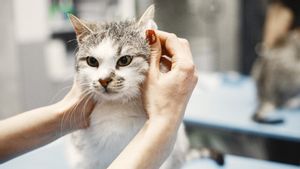JAKARTA - Two cases of human-to-cat transmission of the Sars-Cov-2 virus were discovered by research conducted in England. Researchers from the University of Glasgow discovered the transmission as part of a UK cat population review program.
The two cats that were allegedly infected with COVID-19 come from different owners, different places of residence, to different breeds. What they both experienced was difficulty breathing from medium to severe levels.
Launching The Guardian, Sunday, April 25, researchers from the University of Glasgow believe that the two cats were infected by their owners who had symptoms of COVID-19 before the cats experienced health problems.
The research, published in the journal Veterinary Record, shows there is no evidence of pet-to-human transmission of COVID-19.
However, the results of this study show that domesticated animals can become a reservoir for viruses that allow the spread of COVID-19.
Therefore it is very important to increase understanding regarding the role that pets play in infecting humans related to the disease from Wuhan.
“Currently, animal-to-human transmission has a relatively small chance compared to the possibility of human-to-human transmission in public areas, which is still high. However, as cases of human-to-human transmission decrease, the likelihood of transmission through animals increases. That's why it's important to know the potential source of COVID-19 to be reintroduced to the public, "said researcher from the University of Glasgow Virus Research Center Professor Margaret Hosie.
The woman who is also the head of the research and the author of the study also said that the public must increase their knowledge and understanding that there is a chance that animals will have a share in the spread of COVID-19.
The research is also partnered with the Veterinary Diagnostic Service (VDS) of the Faculty of Veterinary Medicine at the University of Glasgow.
The first cat to be sampled in this study was a four-month-old female kitten with a ragdoll race. From this first cat, it was found that at the end of March 2020 the owner of the first cat had symptoms of COVID-19, but they did not perform a checkup.
The cat was finally found to have difficulty breathing in April 2020, lung examination samples showed damage consistent with viral pneumonia and there was evidence of Sars-CoV-2 infection.
Furthermore, for the second cat, which is a six-year-old female cat with a Siamese breed, the cat lives with an owner who is confirmed to have tested positive for COVID-19.
Just like the first cat, this second cat also has respiratory problems but to a mild degree and can be cured. Apparently, the results of the swab conducted by VDS showed that the cat was infected with COVID-19.
The study, which was conducted between March and July 2020, ended in the conclusion that there were two cases because the frequency of human-to-animal transmission of COVID-19 tended to be underestimated, and testing on animals was limited.
The English, Chinese, Japanese, Arabic, and French versions are automatically generated by the AI. So there may still be inaccuracies in translating, please always see Indonesian as our main language. (system supported by DigitalSiber.id)













